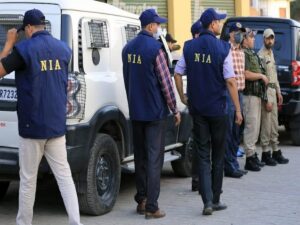In an era where the intricacies of terrorism and organised crime have become entwined in a complex web, the National Investigation Agency (NIA) of India has emerged as a vigilant protector of the nation’s security. The past 20 days have borne testament to the agency’s relentless and multifaceted offensive against various threats to the country. This deep dive aims to unravel and understand the meticulous operations executed by the NIA, emphasising their breadth and significance.
1. The Grand Multi-State Crackdown:
One cannot discuss the NIA’s recent activities without first addressing their colossal multi-state operation, an intricate orchestration that encompassed Punjab, Haryana, Rajasthan, Uttarakhand, Uttar Pradesh, Delhi, and Chandigarh. With 53 raids executed in a single day, the agency cast a wide net targeting affiliates of the dreaded terrorist, Arsh Dalla, and key figures among the underworld of gangsters and drug traffickers.
This operation was a strategic masterstroke aimed at dismantling the terror-gangster-smuggler nexus, which had been flexing its muscles with a spate of high-profile crimes. Prominent victims of this syndicate included Maharashtra builder Sanjay Biyani, mining trader Mehal Singh, and international Kabaddi player Sandeep Nangal Ambia. The sheer audacity of these crimes, executed with near impunity, underscored the urgency of the NIA’s response.
Key Findings:
• An impressive tally of over 370 locations have been raided since the NIA’s intensified crackdown began.
• The seizures from these operations are equally noteworthy. This includes a cache of 38 arms, 1,129 rounds of ammunition, and 331 digital devices — potential treasure troves of intelligence.
• On the financial front, 87 bank accounts were frozen, effectively cutting off the financial lifeline of these criminal enterprises. 13 properties were attached, and significant assets based overseas were identified and confiscated.
2. Tackling Kashmir’s Unrest and Manipur’s Intricacies:
Jammu and Kashmir, a region often embroiled in geopolitical tension, saw decisive action with 10 leaders of the banned Jammu and Kashmir Liberation Front (JKLF) being denied bail. This was a calculated move, addressing the leadership structure of separatist movements in the region.
In the northeastern state of Manipur, the NIA’s arrest of Moirangthem Anand Singh marked a strategic victory. Singh’s links with Myanmar-based rebel factions revealed a broader international nexus, suggesting a more expansive network of intrigue than previously assumed.
3. Sikhs for Justice (SFJ) & The Global Web:
In a move that reiterates the NIA’s expansive operational reach, properties of Canada-based Gurpatwant Singh Pannu, associated with the banned SFJ outfit, were confiscated in Amritsar and Chandigarh. Pannu, a known promoter of extremist ideologies, has been a significant figure on the NIA’s radar.
4. Puducherry Assassination and the Anatomy of Terror:
The methodical investigation into the assassination of political figure Senthil Kumaran in Puducherry led to a well-prepared charge sheet against 13 perpetrators. This incident, and the subsequent NIA investigation, revealed the lengths to which criminal organisations are willing to go to further their agendas, using violence as a tool to instil fear.
5. Babbar Khalsa International (BKI) and the International Footprint:
In a significant move on Sep 20, the NIA highlighted its focus on five operatives from BKI, unveiling an expansive network spanning multiple countries. This organisation’s intent became clear – destabilising the nation using funds from various illicit means.
6. Thwarting Financial Channels and Gold Smuggling:
Financial channels have always been the lifeblood of organised crime and terrorism. Acknowledging this, the NIA’s arrest of Ratheesh at Thiruvananthapuram airport highlighted the importance of curbing such illicit financial inflows. Ratheesh’s role in smuggling gold using diplomatic baggage had implications not only for the Indian economy but also for national security.
7. Dawood’s Syndicate & Mumbai’s Underbelly:
Mumbai’s criminal underbelly, led by the likes of Dawood Ibrahim, has been a consistent thorn in India’s side. The denial of bail to Salim Qureshi, an associate of Dawood, once again emphasised the NIA’s commitment to dismantling such iconic crime syndicates.
8. ISIS: A Persistent Threat:
With global terrorism evolving, the NIA’s recent operations against ISIS modules in Tamil Nadu and Telangana reaffirm the need for constant vigilance. From radicalization campaigns disguised as Arabic language classes to a car bomb in Coimbatore, the ISIS footprint in India is growing, necessitating decisive counteractions.
Conclusion:
The NIA’s operations over the past 20 days have been nothing short of a masterclass in counter-terrorism and organised crime response. By addressing threats ranging from localised crime syndicates to international terror networks, the NIA is ensuring the safety of the nation’s populace. As the landscape of threats continues to evolve, the National Investigation Agency’s.









